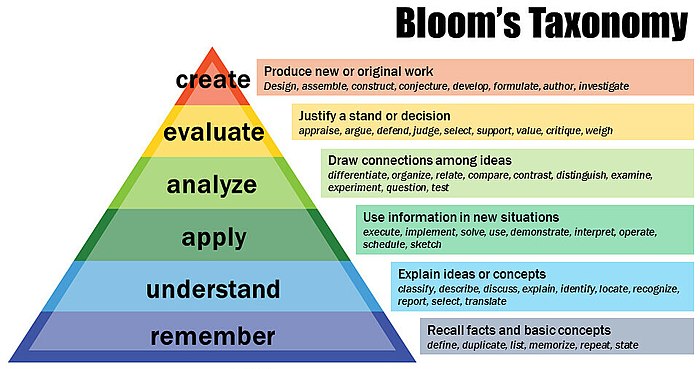QA4ODFL2/Assessment/Rigour
As teachers, you probably know about the Bloom’s Taxonomy, a very important theory in teaching and learning. Figure 3 below reminds you of the six levels of the Taxonomy. If you want to learn more about the Theory you can find more information at the following link: (/https://media.citt.ufl.edu/resources/blooms/index.html)
This theory is useful in designing teaching and learning that covers different levels of cognitive domains. In fact, it speaks to the knowledge and skills that one needs to cope with the challenges of work and life in general. For example, we do not need people who can only remember, or can only describe or explain. We need people who can do all these things and also analyse, evaluate and create. We need to cover these various cognitive skills when we design teaching and learning as much as we need to do so when we design assessment.
To ensure that you cover all the cognitive domains when you set an assessment test, you can use a matrix table like Table 5. The table shows how you can distribute the test items across the cognitive domains.
Table 5: Matrix for analysing the cognitive levels in an assessment test
| Topic | Concept/ Skills | Level | Number of items | |||||
| Research problem/ Hypothesis | Understand research problem & formulate it | 1 | 1 | 2 | ||||
| Research Topic | Rationale stating | 1 | 1 | 1 | 3 | |||
| Research methodology | Types and importance | 1 | 1 | 1 | 2 | 5 | ||
| Data instruments | Understand, create and apply | 1 | 1 | 1 | 3 | |||
| Data analysis | Apply & create | 1 | 2 | 3 | ||||
| Report writing | Understand, apply, analyse, evaluate & create | 1 | 1 | 1 | 1 | 4 | ||
| Total | Understand research problem & formulate it | 1 | 5 | 4 | 1 | 1 | 8 | 20 |
In Table 5, the numbers represent items that are under each level. For example, for methodology you have to remember, understand and apply different kinds of research methodology, and you might have to be more creative in using a particular methodology in your study. With data collection instruments you have to understand and apply some instruments, and you may have to create your own. Over the whole exercise you have quite a good balance across all the domains, and this makes your test well balanced in terms of coverage of the various cognitive levels.
